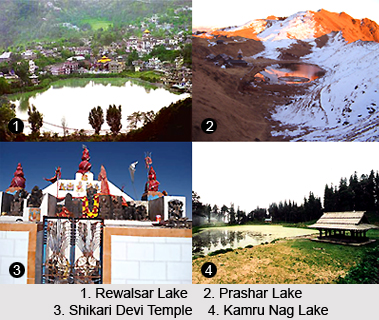Tourism in Mandi District comprises of various lakes and other tourist attractions like the pilgrimage spots, which draws a large number of people from India and from abroad. Mandi District is situated on the banks of the Beas River. Mandi District has a rich culture and history represented by its temples which are a major tourist`s draw.
Pilgrimage Tourism in Mandi District
Shikari Devi Temple: Shikari Devi Temple is the temple situated in Mandi District. The high altitude temple is a perfect place for trekking and the place for solitude. The tranquillity for trekkers at a height of 3,332 metres above sea level is the place of pilgrimage and the adventure.
Nature Tourism in Mandi District
Rewalsar Lake: Rewalsar Lake is shaped quite like a square and with a shoreline of 735 meters. It is an important pilgrimage. This lake is known for its floating island. The lake is also associated with Nag cult or serpent worshipping. The lake water is believed to be flowing underground from Rewalsar to `Nagchala` (a place 10 km from Mandi on the Mandi-Shimla National Highway). The Hindus believe that it was here that the `Lomas Rishi` held his penance in devotion to Lord Shiva. Overwhelmed, Shiva gave the rishi, the seven floating islands in reward. This is a very sacred place.
 Prashar Lake : This Lake is situated in a cup like valley. A temple of great scenic beauty is also situated here. With deep blue waters, this beautiful lake is held sacred to the sage Prashar (rishi). A three-tiered Pagoda-like temple dedicated to the sage lies by the lake - and he is regarded to have meditated here. No other temple in the Western Himalayas can rival the grandeur of the settings of Prashar Rishi. A community fair is held here in the in the month of June every year, where people gather from all neighbouring villages. This lake is fed by small mountain streams.
Prashar Lake : This Lake is situated in a cup like valley. A temple of great scenic beauty is also situated here. With deep blue waters, this beautiful lake is held sacred to the sage Prashar (rishi). A three-tiered Pagoda-like temple dedicated to the sage lies by the lake - and he is regarded to have meditated here. No other temple in the Western Himalayas can rival the grandeur of the settings of Prashar Rishi. A community fair is held here in the in the month of June every year, where people gather from all neighbouring villages. This lake is fed by small mountain streams.
Barot: Barot is a nice picnic spot situated at a distance of 33 km. from Mandi on Mandi - Pathankot Highway. Barot is famous for trout fishing and a ropeway that attracts the tourists.
Sundernagar: Beautifully fertile valley receives the tired traveller with open arms at a distance of 25 km from Mandi on the National Highway. Waters of two rivers - Beas River and Sutlej River have been wedded here to give birth to Asia`s biggest Hydel Project generation electricity for the country. Devi Temple, Sukhdev Vatika and the temple of Mahamaya are the well known places of worship.
Jogindernagar: Jogindernagar is the terminus of narrow gauge line from Pathankot-Jogindernagar. A journey from Jogindernagar to Barot in the interior of Mandi district, on the haulage trolley is thrilling. Bassi Power Station is 5 km. and next to it is `Macchial` considered being a sacred spot. It is worth a visit on account of Shanan Hydel Project built by the Britishers Pandoh Dam, Slapper Hydel Project, Rock Salt Mines at Gumma and Darang are other attractions around the main town.
Tatta Pani: Resting deep in a scenic valley and surrounded by hills. It is located on the right bank of Sutlej River at an altitude of 656 meters. This natural sulphur spring is pure and has curative power for various kings of bodily ailments. The water level of the spring keeps changing with the fluctuation in the water level of the river. Tatta-pani means hot water.
Chidi: This little hamlet in an apple growing area is blessed with breathtaking beauty. There are numerous small temples of considerable antiquity not too far away. Chindi is easily approachable via Tatta Pani from Shimla. It is 107 km. from Mandi.
Janjehli: At a distance of 67 k.m. from Mandi, Janjehli is a paradise for hikers, offering treks up to a height of 3,300 metres. After covering 32 k.m. by a motorable road up to Gohar and rest of the journey is on foot. There is a beautiful and well furnished rest house to stay overnight; from here Janjehli is a scant 20 km away through bridle path.
Kamru Nag Lake: Kamru Nag Lake is the place where the tourist can enjoy the beauty of nature. This lake is situated at about 3334 meters above the sea level.
Tourism in Mandi is mainly related to Rewalsar Lake which attracts uncountable number of tourists throughout the year. Tourism in Mandi also offers a fine trek to amazingly beautiful Prashar Lake. The whole area around Prashar area is natural paradise. The trekking area of Janjhehli offers tourists a chance to trek at a height of 3300 meters above sea level. Mandi is also a rapidly developing city of Himachal Pradesh. This place is also ideal for shopping.
Tourism in Mandi offers a unique picture of developing Himachal Pradesh with some very beautiful and sacred places to visit, hotpring with healing properties, amazing trekking area and a very beautiful escape to Shikari Devi Temple.



















